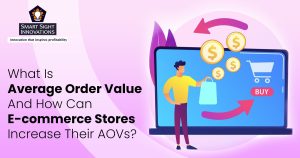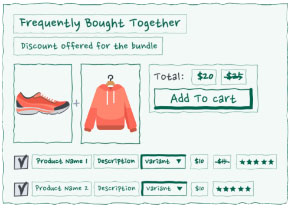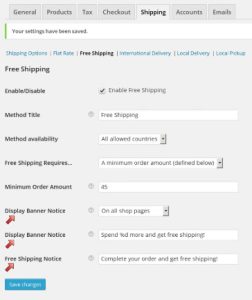 As customer interactions with e-commerce stores continue to evolve, metrics like Average Order Value (AOV) stand out as pivotal indicators of business health and growth.
As customer interactions with e-commerce stores continue to evolve, metrics like Average Order Value (AOV) stand out as pivotal indicators of business health and growth.
This article explains details about the average order value (AOV) in the e-commerce segment and details some of the best practices for e-commerce store owners to increase customer basket size & profits for your e-commerce store.
What Is Average Order Value (AOV)?
Average Order Value, commonly referred to as AOV, is a fundamental e-commerce metric that represents the average amount spent by a customer in a single transaction. While AOV provides insights into the spending patterns of customers, it also serves as a valuable benchmark for e-commerce businesses to evaluate their sales strategies, pricing models, and overall performance.
How to Calculate AOV?
While the concept of AOV offers valuable insights into customer spending behaviors in e-commerce, understanding the mathematics behind its calculation is essential for businesses aiming to harness its full potential. Mathematically, AOV is a straightforward metric derived from two primary variables — total revenue and the number of orders. The formula to calculate AOV is:
AOV = Revenue/Number of Orders
To illustrate this with a simple example, consider an online electronics store offering a mix of products ranging from headphones to smart home devices. In a promotional campaign, it observed a surge in sales with total revenue amounting to $50,000 from 1,000 orders.
In this scenario, the AOV of the e-commerce store would be:
AOV = $50,000/1,000 = $50
With an AOV of $50, the store could infer that customers were purchasing a combination of products or opting for higher-priced items, thereby maximizing revenue potential.
Benchmarking Your AOV
Knowing your AOV is crucial for understanding your e-commerce success. But simply knowing your own number isn’t enough. To truly optimize your strategy, you need to see how you stack up against your industry peers. That’s where benchmarking your AOV comes in.
Think of it like stepping onto the e-commerce track and glancing at the scoreboard alongside your competitors. You see where you stand, who’s ahead, and who’s lagging behind. This valuable information allows you to identify areas for improvement and refine your tactics for a winning performance.
How to Benchmark Your AOV?
- Identify your industry category: This could be broad, like “fashion,” or more specific, like “women’s athletic wear.” The closer you target your category, the more relevant the comparison.
- Research industry averages: Many resources provide benchmark data for various e-commerce categories. Check out reports from organizations like Oberlo, Statista, or eMarketer, or industry-specific publications.
- Compare and analyze: Once you have your numbers, it’s time to compare! Is your AOV above, below, or on par with the industry average? Are there any subcategories within your industry that perform significantly better or worse? Understanding these discrepancies is key to uncovering potential opportunities.
To get you started, here’s a chart of the average AOVs for various e-commerce categories based on a study carried out by Dynamic Yield.
| Category | Average AOV (USD) |
| Luxury & Jewelry | $162 |
| Home & Furniture | $246 |
| Fashion, Accessories & Apparel | $141 |
| Beauty & Personal Care | $77 |
| Food & Beverage | $91 |
| Multi-Brand Retail | $83 |
| Pet Care & Veterinary Services | $66 |
| Consumer Goods | $116 |
AOV benchmarks are just starting points. Your unique brand, target audience, and pricing strategy will influence your numbers. Use the information as a guide, not a hard rule.
Identifying Areas for Improvement:
- If your AOV is below the average:
- Analyze your product mix and pricing. Are you offering enough high-value items? Can you adjust pricing strategies to encourage larger purchases?
- Review your website design and user experience. Are customers easily finding complementary products or upsell opportunities?
- If your AOV is above the average:
- Celebrate your success! But don’t get complacent. Look for ways to further refine your strategy and maintain your competitive edge.
- Investigate what successful brands in your category are doing. Can you apply any of their tactics to your own business?
Factors Affecting AOV
AOV is the melody of your e-commerce success. It tells you how much customers spend on average per purchase, and like any good song, it’s influenced by a harmonious blend of factors. The three key instruments here are product pricing, promotions, and shipping costs.
Product Pricing
Imagine a concert hall. The ticket prices for different seats reflect their value and influence the audience’s choices. Similarly, your product pricing sets the tone for AOV.
- High-End Harmonies: Premium products with higher price tags naturally pull up AOV. Think of exclusive jewelry brands or luxury furniture stores.
- Value-Driven Melodies: Affordable products with competitive pricing can lead to higher order volume, indirectly impacting AOV. Clothing brands with frequent discounts or grocery stores with value packs fall into this category.
- Finding the Right Balance: The key is to strike a balance between price and perceived value. Offer products at a price point that resonates with your target audience and incentivizes them to fill their virtual shopping cart.
Promotions
Think of promotions like musical interludes that add excitement and encourage larger orders.
- Discount Duets: Discounts and coupons can entice customers to add more items to their cart to reach a minimum threshold for free shipping or a higher discount tier.

- Buy One, Get One Free (BOGO) Ballads: These promotions encourage customers to buy two or more items, directly boosting AOV.

- Strategic Solos: Targeted promotions for specific product categories or high-value items can nudge customers towards larger purchases without compromising overall profitability.

Shipping Costs
Shipping costs can act like a conductor, influencing the flow of orders and AOV.
- Free Shipping Symphonies: Offering free shipping above a certain order value can incentivize customers to spend more and reach the threshold.
- Flat Fee Foxtrots: Flat shipping fees, regardless of order size, can make smaller orders more appealing, potentially lowering AOV.
- Calculated Cadences: Dynamically calculating shipping costs based on order weight or location can ensure fairness while optimizing profitability.
You need to skillfully orchestrate these elements to achieve the desired AOV. Analyze your customer behavior, industry benchmarks, and profit margins to find the perfect harmony for your e-commerce store.
Strategies to Increase AOV
- Product Bundling and Upselling: Creating attractive product bundles and suggesting relevant upsells to encourage larger purchases.
- Minimum Order Discounts and Free Shipping: Implementing minimum order thresholds for discounts and free shipping to incentivize larger basket sizes.
- Personalized Product Recommendations: Utilizing data and AI to recommend complementary products to individual customers based on their browsing and purchase history.
- Effective Product Pages and Cross-Selling: Optimizing product pages with high-quality visuals, detailed descriptions, and clear calls to action, and incorporating well-placed cross-selling opportunities.
- Abandoned Cart Recovery: Engaging abandoned cart visitors with targeted email campaigns and offering incentives to complete their purchases.
Advanced AOV Optimization Strategies
- Dynamic Pricing and Promotions: Implementing dynamic pricing strategies and personalized promotions based on customer behavior and market trends.
- Loyalty Programs and VIP Tiers: Creating loyalty programs with tiered benefits and exclusive offers to encourage repeat purchases and higher spending.
- Subscription Services and Recurring Revenue: Offering subscription models and recurring billing options for consistent revenue and increased customer lifetime value.
- Measuring and Analyzing AOV Performance: Keep an eagle eye on your AOV! Monitor its ups and downs to see the impact of your strategies and adjust course for continual optimization.
- A/B Testing and Experimentation: Can’t decide on the best approach? Let data be your guide! Test different strategies through A/B tests to discover what truly moves the AOV needle.














